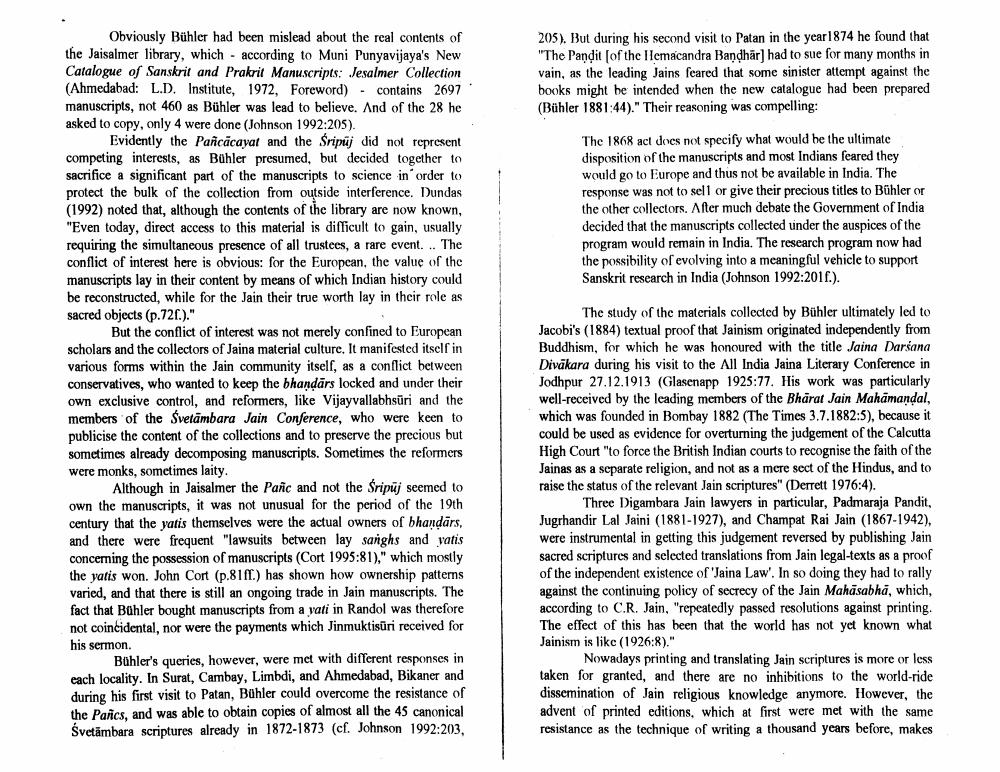Book Title: Jainism And Western World Author(s): Peter Flugel Publisher: Peter Flugel View full book textPage 5
________________ 205). But during his second visit to Patan in the year 1874 he found that "The Pandit (of the Ilemacandra Bandhar) had to sue for many months in vain, as the leading Jains feared that some sinister attempt against the books might be intended when the new catalogue had been prepared (Bühler 1881:44)." Their reasoning was compelling: The 1868 act does not specify what would be the ultimate disposition of the manuscripts and most Indians feared they would go to Europe and thus not be available in India. The response was not to sell or give their precious titles to Bühler or the other collectors. After much debate the Government of India decided that the manuscripts collected under the auspices of the program would remain in India. The research program now had the possibility of evolving into a meaningful vehicle to support Sanskrit research in India (Johnson 1992:2011.). Obviously Bühler had been mislead about the real contents of the Jaisalmer library, which according to Muni Punyavijaya's New Catalogue of Sanskrit and Prakrit Manuscripts: Jesalmer Collection (Ahmedabad: L.D. Institute, 1972, Foreword). contains 2697 manuscripts, not 460 as Bühler was lead to believe. And of the 28 he asked to copy, only 4 were done (Johnson 1992:205). Evidently the Pancacayat and the Sripaj did not represent competing interests, as Buhler presumed, but decided together to sacrifice a significant part of the manuscripts to science in order to protect the bulk of the collection from outside interference. Dundas (1992) noted that, although the contents of the library are now known, "Even today, direct access to this material is difficult to gain, usually requiring the simultaneous presence of all trustees, a rare event... The conflict of interest here is obvious: for the European, the value of the manuscripts lay in their content by means of which Indian history could be reconstructed, while for the Jain their true worth lay in their role as sacred objects (p.726.)." But the conflict of interest was not merely confined to European scholars and the collectors of Jaina material culture. It manifested itself in various forms within the Jain community itself, as a conflict between conservatives, who wanted to keep the bhandārs locked and under their own exclusive control, and reformers, like Vijayvallabhsüri and the members of the Svetambara Jain Conference, who were keen to publicise the content of the collections and to preserve the precious but sometimes already decomposing manuscripts. Sometimes the reformers were monks, sometimes laity. Although in Jaisalmer the Panc and not the Sripuj seemed to own the manuscripts, it was not unusual for the period of the 19th century that the yatis themselves were the actual owners of bhandars, and there were frequent "lawsuits between lay sanghs and vatis concerning the possession of manuscripts (Cort 1995:81)," which mostly the yatis won. John Cort (p.811.) has shown how ownership patterns varied, and that there is still an ongoing trade in Jain manuscripts. The fact that Bühler bought manuscripts from a vati in Randol was therefore not coincidental, nor were the payments which Jinmuktisüri received for his sermon. Bühler's queries, however, were met with different responses in each locality. In Surat, Cambay, Limbdi, and Ahmedabad, Bikaner and during his first visit to Patan, Bühler could overcome the resistance of the Panics, and was able to obtain copies of almost all the 45 canonical Svetämbara scriptures already in 1872-1873 (cf. Johnson 1992:203, The study of the materials collected by Bühler ultimately led to Jacobi's (1884) textual proof that Jainism originated independently from Buddhism, for which he was honoured with the title Jaina Darsana Divakara during his visit to the All India Jaina Literary Conference in Jodhpur 27.12.1913 (Glasenapp 1925:77. His work was particularly well-received by the leading members of the Bharat Jain Mahamandal, which was founded in Bombay 1882 (The Times 3.7.1882:5), because it could be used as evidence for overturning the judgement of the Calcutta High Court "to force the British Indian courts to recognise the faith of the Jainas as a separate religion, and not as a mere sect of the Hindus, and to raise the status of the relevant Jain scriptures" (Derrett 1976:4). Three Digambara Jain lawyers in particular, Padmaraja Pandit, Jugrhandir Lal Jaini (1881-1927), and Champat Rai Jain (1867-1942), were instrumental in getting this judgement reversed by publishing Jain sacred scriptures and selected translations from Jain legal-texts as a proof of the independent existence of 'Jaina Law'. In so doing they had to rally against the continuing policy of secrecy of the Jain Mahasabha, which, according to C.R. Jain, "repeatedly passed resolutions against printing. The effect of this has been that the world has not yet known what Jainism is like (1926:8)." Nowadays printing and translating Jain scriptures is more or less taken for granted, and there are no inhibitions to the world-ride dissemination of Jain religious knowledge anymore. However, the advent of printed editions, which at first were met with the same resistance as the technique of writing a thousand years before, makesPage Navigation
1 ... 3 4 5 6 7
